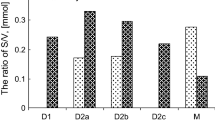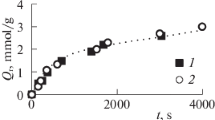Summary
Lignin is completely amorphous, being built up of dehydrogenated coniferyl alcohol units, and it is highly branched, as can be deduced from spreading measurements. Its molecular weight can be estimated at 10,000 to 100,000 and furthermore, it is bonded by either linkages to polysaccharides (grafted on, as it were.) The tissue lying between the bark and the xylem in which wood is formed, namely the cambium, is abundantly filled with sap in the early summer. The sap contains coniferin, the glucoside of coniferyl alcohol I. Experiments with radioactive coniferine have demonstrated that it is incorporated into the lignin of the freshly formed xylem cell bordering on the cambium. Coniferin itself is produced from phenyl alanine or another acid of the C6-C3 group. The enzyme laccase occurs in the sap of the cambium and surrounding tissues. This enzyme is able to dehydrogenate, i. e. to remove hydrogen from coniferyl alcohol, the point of attack being the phenol group. This results in the formation of lignin. However, coniferyl alcohol itself is not directly available - only its glucoside, coniferin. This implies that an enzyme (glucosidase), which splits coniferin into glucose and coniferyl alcohol, must be present. This glucosidase has been shown up by means of a reaction which leads to the formation of indigo (upper part of Fig. 3). Hence, the process of lignification proceeds as follows: coniferin encounters the glucosidase and the conifery alcohol liberated is converted into lignin in situ. Lignin is a filling agent in and between the cellulose fibres and, together with the hemicelluloses, it assumes the same rôle as the cement in reinforced concrete.
Coniferyl alcohol can also be treated with laccase in vitro, in the presence of oxygen. A number of radicals are formed from the coniferyl alcohol thereby; these combine with each other. Further dehydrogenation leads to biosynthetic lignin, which is identical with the lignin in coniferous wood. Attempts to elucidate the chemical structure of lignin by degradation did not get very far. The most important discovery was that phenyl carbinols and their ethers react in sulfite and sulfide pulping (B. Holmberg). However, after it was discovered that the biosynthetic lignin formed in vitro is identical with conifer lignin in vitro, it was possible to study the process of lignification using the intermediates formed at the start of the in vitro process. So far, eleven intermediates have been isolated and their structures explained, including the most important ones, i. e. those which occur predominatly. The radicals mentioned above (II, III and IV in the table on page 285) are formed first. These combine among themselves giving V, VI, VII and VIII. The aldehydes of I, V and IX also occur. Larger, aggregates, e.g. XI, are formed by further dehydrogenation, e.g. of VI. Substance VIII is a key substance. IX is produced from it by addition of water, but VIII also tends to combine with polysaccharides, giving substances according to the pattern of X. Phenolic groups, e.g. that of coniferyl alcohol I or of substance V, can be added to VIII, yielding XII and XIII. This scheme explains the formation of conifer lignin. The greater part of the units are linked together by removal of hydrogen and the resultant subsequent condensation. The addition of phenols or polysaccharides onto the definite intermediate VIII proceeds simultaneously. All of these substances are phenols, too, and can react further according to both of these principles. This includes the polysaccharide compound X. In this way, lignin is chemically combined with (grafted onto) the polysaccharide components of the wood via ether bonds (not glucoside links).
The picture of the constitution of lignin that can be drawn up from the intermediates identified so far is able to explain all the reactions of lignin.
Conifer lignin is not formed from coniferyl alcohol in the same way as cellulose is from glucose, with all the units being identical and similarly linked. On the contrary, the units of dehydrogenated coniferyl alcohol occur in numerous different forms that are condensed and etherified together in various ways. Moreover, the lignin polymolecular does not grow until by unit but larger and smaller prefabricated aggregates are cemented together by freshly formed radicals of dehydrogenated coniferyl alcohol.
Similar content being viewed by others
Author information
Authors and Affiliations
Rights and permissions
About this article
Cite this article
Freudenberg, K. Entstehung des Holzes und des Lignins. Holz als Roh-und Werkstoff 18, 282–287 (1960). https://doi.org/10.1007/BF02626116
Issue Date:
DOI: https://doi.org/10.1007/BF02626116




